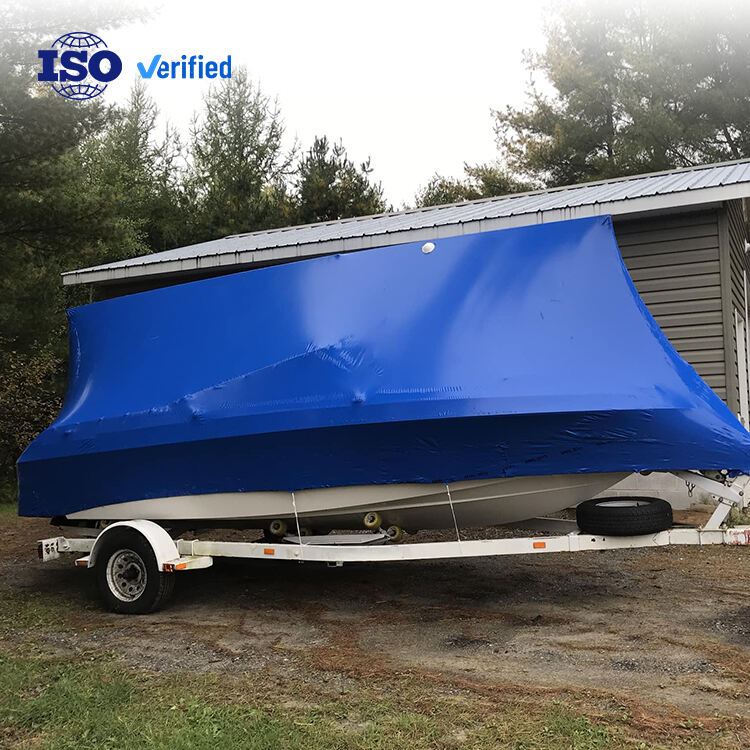הכרת מדידות סרט כיווץ תעשייתי
עולם חומרי האריזה עבר תהליך התפתחות משמעותי, ו סרט התכווצות סרט כיווץ הפך לאחד האלמנטים המרכזיים בשמירה על המוצר ובהצגתו. כשמדובר בעובי סרט התכווצות עובי, בחירת הגודל הנכון יכולה להפוך את ההגנה האופטימלית ממאריז מיותרים. יצרנים מודרניים ומומחים לאימballage צריכים להבין את הדגשים שבין עוביי הניילון השונים, במיוחד האפשרויות הנפוצות של 150 מיקרון, 200 מיקרון ו-250 מיקרון, כדי לקבל החלטות מושכלות ביחס לצרכים של האריזה שלהם.
מדידות עובי של פילם התכווצות, המבוטאות במיקרונים (מיקרו), משפיעות ישירות על חוזק הפילם, ראותו ועל יכולת ההגנה שלו. מדריך מקיף זה בוחן את התכונות, השימושים וביקורות הבחירה עבור מדדים שונים של פילם התכווצות, ועוזר לך לבצע את הבחירה היעילה והכלכלית ביותר עבור צורכי האריזה הספציפיים שלך.
המדע שמאחורי עובי פילם התכווצות
מבנה חומרי וביצועים
התועלת של פילם התכווצות נובעת מהמבנה המולקולרי הייחודי שלו, אשר מגיב לחום על ידי התכווצות אחידה סביב מוצרים. עובי הפילם מושך תפקיד חשוב בתהליך זה, ומשפיע גם על יחס ההתכווצות וגם על המראה של האריזה הסופית. מדד הפילם קשור ישירות לחוזקו, התנגדותו לניקוב וליכולתו לשמור על מתח מתאים במהלך תהליך ההתכווצות.
האוריינטציה המולקולרית של שרשראות הפולימר בתוך הסרט הופכת להיות חזקה יותר ככל שהעובי גדל. תוצאה זו מובילה לשיפור בתכונות המכאניקליות ובהגנה טובה יותר כנגד גורמים חיצוניים. הבנת הקשר הזה עוזרת למקצועי אריזה לבחור את העובי המתאים ליישומים ספציפיים.
השפעת הטמפרטורה והגורמים הסביבתיים
עוביי אריזת שרייק שונים מגיבים באופן ייחודי ליישור החום ולתנאי הסביבה. אריזות עבות דורשות בדרך כלל טמפרטורות גבוהות יותר וזמן חשיפה ממושך יותר כדי להשיג שרייה אופטימלית, בעוד אריזות דקות מגיבות מהר יותר אך עשויות להציע הגנה פחותה. יש לשקול גורמים סביבתיים כגון רטיבות, תנאי אחסנה ודרישות טיפול בבחירת עובי האריזה המתאים.
בשל תהליך הקיצוץ, שליטה בטמפרטורה הופכת להיות קריטית יותר ככל שגובר עובי הסרט. יש לכייל את מנהרות החום ואת ציוד החיתוך באופן זהיר כדי להתאים את עוביי הסרט השונים.
ניתוח יישומים של סרט קיצוץ בגודל 150 מיקרון
מוצרים ואינדוסטריות אידיאליים
סרט הקיצוץ בגודל 150 מיקרון מייצג אופציה אמצעית מצוינת עבור מגוון רחב של יישומים ב אריזה. עובי זה מספק הגנה מספקת תוך שמירה על עלות ישימה לצרכים של אריזה בינוניים. בתעשייה כמו ייצור משקאות, מוצרי טיפול אישי וסחורות למינור תעשה שימוש נרחב בסרט בגודל 150 מיקרון בזכות תכונותיו האיזוניות.
עובי זה מציע חוזק מספק עבור רוב המוצרים לצרכנים, תוך אפשור מהירות עיבוד יעילה וצריכת חומר אופטימלית. גמישות הסרט הופכת אותו מתאים במיוחד ל عمليות אריזה בגדלים גדולים בהנהלת עלויות היא קריטית.
מאפייני ביצוע
ב-150 מיקרון, קרום התכווצות מספק ביצועים אמינים בסביבות אריזה סטנדרטיות. החומר מספק שקיפות טובה, התנגדות מתונה לניקור והתכווצות עקבית. עובי זה מאפשר עיבוד מצוין ועובד היטב עם רוב ציוד האריזה האוטומטי.
התכונות האופטיות של הקרום במדד זה שומרות על נראות המוצר תוך כדי מתן הגנה מספקת מפני קרינת UV וגורמים סביבתיים. שלמות האריזה נשארת יציבה תחת תנאי טיפול ותשלום רגילים.
יתרונות של קרום התכווצות ב-200 מיקרון
תכונות הגנה מתקדמות
מעבר לقرום התכווצות של 200 מיקרון מספק עמידות Защитה משמעותית גבוהה יותר. עובי זה מציע התנגדות מרשימה לניקור ויציבות מטען מוגזמת, מה שעושה אותו אידיאלי למוצרים כבדים או פריטים שדורשים הגנה נוספת במהלך המשלוח. עליית עוצמת החומר תורמת לשלמות אריזה טובה יותר ולקיטון סיכון לנזק.
הגימור ב-200 מיקרון מציג גם שיפור בתכונות הניהול במערכות אוטומטיות לאיסוי, עם סיכון מופחת לשבירת הסרט או לבעיות בתהליך. עובי זה מספק איזון מצוין בין הגנה לבין יעילות כלכלית ליישומים ממוצעים ועד כבדים.

ניתוח עלות-יתר
בעוד שסרט של 200 מיקרון מייצג השקעה ראשונית גבוהה בהשוואה לגימורים קלים יותר, הקיימות המוגזמת שלו תורמת לעתים קרובות לירידה בכלליות עלות האיסוי. הסבירות הנמוכה לפגיעה בمنتجات והאפשרות לפסולת מופחתת יכולות לאזן את עלויות החומר הגבוהות יותר. בנוסף, הסרט החזק יותר מאפשר לעתים קרובות מהירות תהליך גבוהה יותר ופחות הפסקות בייצור.
ארגונים חייבים לשקול את עלות הבעלות הכוללת, הכוללת את ניצול החומר, יעילות תהליך והגנת המוצר, בעת הערכת סרט של 200 מיקרון ליישומים שלהם. השקעה זו מוכחת לעתים קרובות את שוויה למוצרים המזדקקים להגנה מיטבית או לאלה הנמצאים בתנאי הפצה מאתגרים.
יישום פתרונות כבדים 250 מיקרון
יישומים של הגנה מקסימלית
שקף הכיווץ של 250 מיקרון מייצג את הבחירה המובילה למטרות אריזה כבדות. עובי זה מספק הגנה מקסימלית למוצרים גדולים, כבדים או בעלי ערך גבוה. תחומים העוסקים בציוד תעשייתי, בחלקי רכב או באריזת כמויות גדולות תלו בכוח בשקף של 250 מיקרון בשל עמידותו וקשיותו הגבוהה.
העובי הזה מציע עמידות מקסימלית לניקוב, יציבות מטען מצוינת, והגנה מוגזמת נגד תנאי טיפול קשים. השרף העבה יוצר מחסום איתן נגד גורמים סביבתיים ופיזיקליים, ולכן הוא אידיאלי למוצרים הדורשים את רמת ההגנה הגבוהה ביותר.
שיקולים בעיבוד
בעבודה עם פילם כיווץ של 250 מיקרון יש צורך ב주의 מיוחדת לפרמטרי עיבוד. החומר העבה יותר מחייב הגדרות חום גבוהות יותר ועשוי להזדקק לזמן המתנה ממושך יותר במבחרי כיווץ. ציוד ההאריזה חייב להיות מכוּן כראוי כדי להתמודד עם עובי החומר המוגזם ביעילות.
למרות דרישות העיבוד המורכבות יותר, הרווחים בעבודה עם פילם של 250 מיקרון הם לעיתים קרובות גדולים יותר מהקשיים בישומים הדורשים הגנה מקסימלית. הכשרה מתאימה של הצוות ואופטימיזציה של הציוד מבטיחים יישום מוצלח של פתרון כבד זה.
שאלות נפוצות
איך עובי פילם הכיווץ משפיע על מראה האריזה?
עובי השרף משפיע ישירות על מראה האריזה הסופית באמצעות גורמים כגון שקיפות, ברק וסיום פני השטח. שרטים דקים יותר מציעים בדרך כלל שקיפות טובה יותר אך עשויים להציג קמטים רבים יותר, בעוד שרטים עבים יותר מספקים מראה חזק יותר עם שקיפות מעט מופחתת. העובי הנבחר צריך לאזן בין מראה מושך לבין דרישות הגנה.
אילו תפקיד ממלא עובי שרף השרף בתהליך מהירות המכונה?
עובי השרף משפיע משמעותית על מהירות העיבוד בשורות האריזה. שרטים דקים יותר מאפשרים בדרך כלל עיבוד מהיר יותר אך עשויים להיות רגישים יותר לקרעים, בעוד שרטים עבים יותר עשויים לדרוש מהירות נמוכה יותר אך להציע ביצועים יציבים יותר. העובי האופטימלי צריך להתאים לדרישות הייצור ולקapasיטאות המכשור.
מתי כדאי לשקול לעבור לשרף שרף עבה יותר?
שקול שדרוג עובי השרף שלך כאשר אתה מתמודד עם כשלים בתפירה בתדירות גבוהה, נזקי מוצרים במהלך ההפצה או כאשר אתה מטפל באביזרים כבדים או יקרים יותר. בנוסף, אם שרשרת הפצה שלך כוללת טיפול אגרסיבי או תנאים קיצוניים, המעבר לעובי גדול יותר יכול לספק את הגנה נוספת הנדרשת כדי להבטיח את שלמות המוצר.

